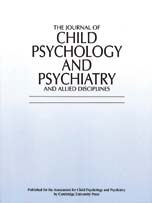Crossref Citations
This article has been cited by the following publications. This list is generated based on data provided by
Crossref.
Macdonald, Wendy
and
Bower, Peter
2000.
Child and adolescent mental health and primary health care: current status and future directions.
Current Opinion in Psychiatry,
Vol. 13,
Issue. 4,
p.
369.
LOEBER, ROLF
BURKE, JEFFREY D.
LAHEY, BENJAMIN B.
WINTERS, ALAINA
and
ZERA, MARCIE
2000.
Oppositional Defiant and Conduct Disorder: A Review of the Past 10 Years, Part I.
Journal of the American Academy of Child & Adolescent Psychiatry,
Vol. 39,
Issue. 12,
p.
1468.
Lambert, Nadine M.
2000.
School Psychology—More than the Sum of Its Parts: Legends on Journeys Through Time.
School Psychology Review,
Vol. 29,
Issue. 1,
p.
120.
Payne, Heather
2000.
The health of children in public care.
Current Opinion in Psychiatry,
Vol. 13,
Issue. 4,
p.
381.
Buitelaar, J.
2001.
Geboren voor het kwaad?.
Neuropraxis,
Vol. 5,
Issue. 6,
p.
139.
Stevenson, Jim
and
Goodman, Robert
2001.
Association between behaviour at age 3 years and adult criminality.
British Journal of Psychiatry,
Vol. 179,
Issue. 3,
p.
197.
ARMSTRONG, CAROL L.
HAYES, KAIRA M.
and
MARTIN, ROBERT
2001.
Neurocognitive Problems in Attention Deficit Disorder.
Annals of the New York Academy of Sciences,
Vol. 931,
Issue. 1,
p.
196.
Babinski, Leslie M.
Hartsough, Carolyn S.
and
Lambert, Nadine M.
2001.
A comparison of self-report of criminal involvement and official arrest records.
Aggressive Behavior,
Vol. 27,
Issue. 1,
p.
44.
Farmer, Thomas W.
Quinn, Mary Magee
Hussey, William
and
Holahan, Thomas
2001.
The Development of Disruptive Behavioral Disorders and Correlated Constraints: Implications for Intervention.
Behavioral Disorders,
Vol. 26,
Issue. 2,
p.
117.
Colledge, E
and
Blair, R.J.R
2001.
The relationship in children between the inattention and impulsivity components of attention deficit and hyperactivity disorder and psychopathic tendencies.
Personality and Individual Differences,
Vol. 30,
Issue. 7,
p.
1175.
Merrell, Kenneth W.
and
Boelter, Eric
2001.
An Investigation of Relationships Between Social Behavior and ADHD in Children and Youth.
Journal of Emotional and Behavioral Disorders,
Vol. 9,
Issue. 4,
p.
260.
MARKS, DAVID J.
NEWCORN, JEFFREY H.
and
HALPERIN, JEFFREY M.
2001.
Comorbidity in Adults with Attention‐Deficit/Hyperactivity Disorder.
Annals of the New York Academy of Sciences,
Vol. 931,
Issue. 1,
p.
216.
Laucht, M.
2001.
Antisoziales Verhalten im Jugendalter: Entstehungsbedingungen und Verlaufsformen.
Zeitschrift für Kinder- und Jugendpsychiatrie und Psychotherapie,
Vol. 29,
Issue. 4,
p.
297.
Elliott, Adrienne K.
and
Mirsky, Allan F.
2002.
The Neurobiology of Criminal Behavior.
Vol. 5,
Issue. ,
p.
111.
HILL-SMITH, ANDREW J.
HUGO, PIPPA
HUGHES, PATRICIA
FONAGY, PETER
and
HARTMAN, DAVID
2002.
Adolescents murderers: abuse and adversity in childhood.
Journal of Adolescence,
Vol. 25,
Issue. 2,
p.
221.
Retz, Wolfgang
Thome, Johannes
Blocher, Detlev
Baader, Miriam
and
Rösler, Michael
2002.
Association of attention deficit hyperactivity disorder-related psychopathology and personality traits with the serotonin transporter promoter region polymorphism.
Neuroscience Letters,
Vol. 319,
Issue. 3,
p.
133.
Coolidge, Frederick L.
Thede, Linda L.
Stewart, Sharon E.
and
Segal, Daniel L.
2002.
The Coolidge Personality and Neuropsychological Inventory for Children (CPNI).
Behavior Modification,
Vol. 26,
Issue. 4,
p.
550.
Robertson, Mary M.
2003.
Mental and Behavioral Dysfunction in Movement Disorders.
p.
443.
van Lier, Pol A.C.
Verhulst, Frank C.
van der Ende, Jan
and
Crijnen, Alfons A.M.
2003.
Classes of disruptive behaviour in a sample of young elementary school children.
Journal of Child Psychology and Psychiatry,
Vol. 44,
Issue. 3,
p.
377.
Goldstein, Sam
and
Gordon, Michael
2003.
Gender Issues and ADHD: Sorting Fact from Fiction.
The ADHD Report,
Vol. 11,
Issue. 4,
p.
7.


